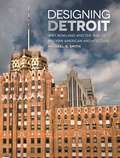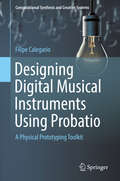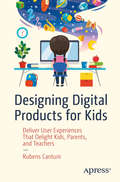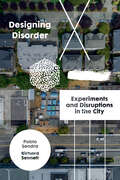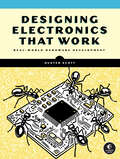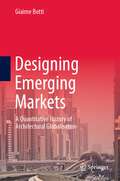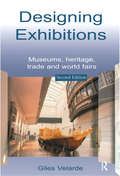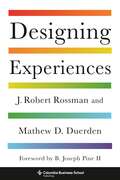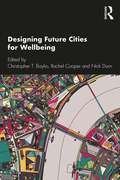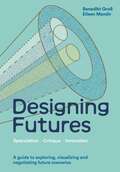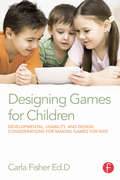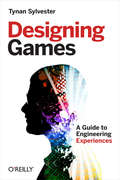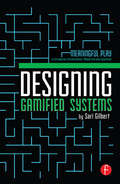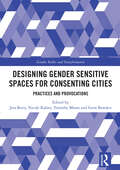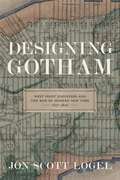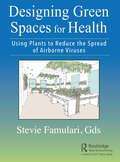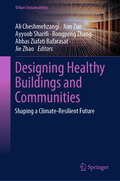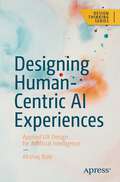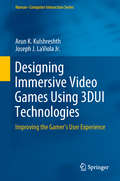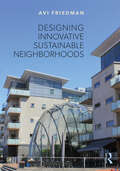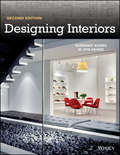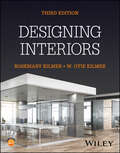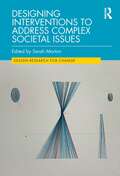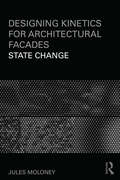- Table View
- List View
Designing Detroit: Wirt Rowland and the Rise of Modern American Architecture (Great Lakes Books Series)
by Michael G. SmithIn the early 1900s, Detroit was leading the nation in architectural innovation and designer Wirt Rowland was at the forefront of this advancement, yet few are even aware of his substantial contribution to the evolution of architectural style. It is widely believed that celebrated local architect Albert Kahn designed many of Detroit’s structures, such as the General Motors and First National Bank buildings. In fact, while Kahn’s efforts were focused on running his highly successful firm, it was Rowland, his chief designer, who was responsible for the appearance and layout of these buildings—an important point in appreciating the contributions of both Kahn and Rowland. During the early twentieth century, Rowland devised a wholly new or “modern” design for buildings, one not reliant on decorative elements copied from architecture of the past. As buildings became more specialized for their intended use, Rowland met the challenge with entirely new design methodologies and a number of improved technologies and materials that subsequently became commonplace. Designing Detroit: Wirt Rowland and the Rise of Modern American Architecture begins with a brief overview of Rowland’s early life and career. Author Michael G. Smith goes on to analyze Rowland’s achievements in building design and as a leader of Detroit’s architectural community throughout both World Wars and the Great Depression. The interdependence of architecture with the city’s fluctuating economic prosperity and population growth is explored, illuminating the conditions for good architecture and the arts in general. The author identifies the influence of Jay Hambidge’s “dynamic symmetry” in Rowland’s work and how it allowed him to employ color as a modern replacement for traditional ornamentation, leading to the revolutionary design of the Union Trust (Guardian) Building, for which he receives nearly unanimous praise in national media. This book is concerned primarily with Rowland’s influence on Detroit architecture, but spans beyond his work in Michigan to include the designer’s broad reach from New York to Miami. A comprehensive appendix includes extensive lists of Rowland’s publications, locations he had designed, and jobs taken on by his firm during his tenure. This book represents new research and insights not previously discussed in either scholarly or general audience texts and will be of interest to casual readers of Detroit history, as well as architecture historians.
Designing Digital Musical Instruments Using Probatio: A Physical Prototyping Toolkit (Computational Synthesis and Creative Systems)
by Filipe CalegarioThe author presents Probatio, a toolkit for building functional DMI (digital musical instruments) prototypes, artifacts in which gestural control and sound production are physically decoupled but digitally mapped. He uses the concept of instrumental inheritance, the application of gestural and/or structural components of existing instruments to generate ideas for new instruments. To support analysis and combination, he then leverages a traditional design method, the morphological chart, in which existing artifacts are split into parts, presented in a visual form and then recombined to produce new ideas. And finally he integrates the concept and the method in a concrete object, a physical prototyping toolkit for building functional DMI prototypes: Probatio. The author's evaluation of this modular system shows it reduces the time required to develop functional prototypes. The book is useful for researchers, practitioners, and graduate students in the areas of musical creativity and human-computer interaction, in particular those engaged in generating, communicating, and testing ideas in complex design spaces.
Designing Digital Products for Kids: Deliver User Experiences That Delight Kids, Parents, and Teachers
by Rubens CantuniChildhood learning is now more screen-based than ever before, and app developers are flocking in droves to this lucrative and exciting market. The younger generation deserves the best, and growing up in a digital world has made them discerning and demanding customers. Creating a valuable user experience for a child is as complex and involved as when designing a typical app for an adult, if not more, and Designing Digital Products for Kids is here to be your guide. Author and designer Rubens Cantuni recognizes the societal importance of a high-quality and ethical app experience for children. There is room for significant improvement in this space, and Cantuni helps you optimize it. Designing Digital Products for Kids walks hopeful developers through digital product design—including research, concept, design, release, marketing, testing, analyzing, and iterating—all while aiming to build specifically for children. Industry experts and their real-world advice are showcased in this book, along with careful advice for the ethics that go along with this unique market. These tips include complex needs regarding mental development, accessibility, conscious screen time limits, and content sensitivity. Children, parents, and teachers alike are hungry for more thoughtful players in the kids’ app space, and Designing Digital Products for Kids is your ticket to successfully developing and educating for the future. What You Will LearnDesign platforms specifically for children, to entertain and educate themWork with a complex audience of parents, teachers and kidsUnderstand how different monetization strategies work in this industry and why Who This Book Is ForUser experience designers, UI designers, product owners, teachers and educators, startup founders. The range of topics is so wide that anyone interested or involved in digital products could find something interesting to learn.
Designing Disorder: Experiments and Disruptions in the City
by Richard Sennett Pablo SendraA manifesto for the Open City: vibrant, disordered, adaptable.In 1970 Richard Sennett published the ground breaking The Uses of Disorder, that the ideal of a planned and ordered city was flawed, likely to produce a fragile, restrictive urban environment. Fifty years later, Sennett returns to these still fertile ideas and alongside campaigner and architect, Pablo Sendra, sets out an agenda for the design and ethics of the Open City. The public spaces of our cities are under siege from planners, privatisation and increased surveillance. Our streets are becoming ever more lifeless and ordered. What is to be done? Can disorder be designed? Is it possible to maintain the public realm as a flexible space that adapts over time? In this provocative essay Sendra and Sennett propose a reorganisation of how we think and plan the social life of our cities. What the authors call 'Infrastructures of disorder' combine architecture, politics, urban planning and activism in order to develop places that nurture rather than stifle, bring together rather than divide up, remain open to change rather than closed off. The book proves that ideas of disorder are still some of the most radical and transformative in debates on 21st century cities.
Designing Electronics That Work: Real-World Hardware Development
by Hunter ScottHow real engineers build electronics—one working piece at a time.If you&’ve ever had a board fail on power-up, spent hours debugging a layout that &“should work,&” or run into a supplier problem just before a deadline—you already know this isn&’t just about theory. It&’s about judgment, decisions, and real-world constraints.Designing Electronics That Work is a guide to all the practical things you won&’t find in a typical electronics textbook. It&’s written for people who already know a little—maybe a lot—about circuits, but want to move faster, make fewer mistakes, and ship working hardware with more confidence.You&’ll learn how to:Define and prioritize requirements so you&’re building the right thing, not just the clever thing Design schematics and layouts to make debugging easier Plan for manufacturability, compliance, and cost from day one Build a lab that helps you work faster, without spending a fortune Troubleshoot problems methodically, even when nothing&’s making sense Hunter Scott has designed electronics for medical devices, RF systems, startups, and art installations. This book reflects what he&’s learned, not as theory, but as practice.You won&’t find chapter-length explanations of what a capacitor is. You will find answers to questions like: Which capacitor should I actually buy? What if the one I spec&’d is out of stock? How do I avoid wasting time and money?Whether you&’re a hobbyist moving beyond Arduino, a new grad learning on the job, or an experienced engineer looking to streamline your process—this book will help you build smarter and avoid problems before they start.
Designing Emerging Markets: A Quantitative History of Architectural Globalisation
by Giaime BottiThis book offers a unique glance into the process of globalisation of the architectural practice during the last three decades through the lenses of innovative methodologies in architectural history based on quantitative data. Focusing on the golden age of globalisation (1990-2019), it investigates the transnational work of more than one thousand architectural firms of different business models from Europe, North America, and the Asia-Pacific in a broad sample of emerging markets: Mainland China, South-East Asia, India, the Persian Gulf, Sub-Saharan Africa, Russia and Kazakhstan, and Latin America. In the book, different thematic geographies are presented to explore the global scope of the contemporary profession, examine significant projects and the structural conditions behind them, and reveal the debates that such works generated. Understanding the global agency of design firms in emerging markets also becomes a way to study different market conditions, modes of production, and architectural trends comparatively and to highlight the shifts that occurred in the profession over the last few decades. The use of quantitative methodologies produces a novel and updated narrative on contemporary architecture in emerging markets grounded in quantitative data rather than in preassumptions and purely qualitative interpretations. Richly illustrated, this book is further enhanced by an ample set of maps, graphs, and tables to visualise data better.
Designing Exhibitions: Museums, Heritage, Trade and World Fairs
by Giles VelardeWhether a world fair, an art gallery, a museum or trade show, all exhibitions deal with the same basic commodities, objects and informative space.A The skill of the exhibition designer lies in using suitable techniques to ensure that the objects are explained in an accessible way to the widest audience. This guide deals with the whole range of exhibition design, describing both people and processes involved in briefing, mounting, maintaining and evaluating exhibitions. It provides the essential principles of designing an exhibition, whatever its nature and size, and serves as an introduction for the non-specialist and a guide to good practice for students and professionals alike.
Designing Experiences: Designing Leisure Experiences: 5th Edition (Columbia Business School Publishing Ser.)
by J. Robert Rossman Mathew D. DuerdenIn an increasingly experience-driven economy, companies that deliver great experiences thrive, and those that do not die. Yet many organizations face difficulties implementing a vision of delivering experiences beyond the provision of goods and services. Because experience design concepts and approaches are spread across multiple, often disconnected disciplines, there is no book that succinctly explains to students and aspiring professionals how to design them.J. Robert Rossman and Mathew D. Duerden present a comprehensive and accessible introduction to experience design. They synthesize the fundamental theories and methods from multiple disciplines and lay out a process for designing experiences from start to finish. Rossman and Duerden challenge us to reflect on what makes a great experience from the user’s perspective. They provide a framework of experience types, explaining people’s engagement with products and services and what makes experiences personal and fulfilling. The book presents interdisciplinary research underlying key concepts such as memory, intentionality, and dramatic structure in a down-to-earth style, drawing attention to both the macro and micro levels. Designing Experiences features detailed instructions and numerous real-world examples that clarify theoretical principles, making it useful for students and professionals. An invaluable overview of a growing field, the book provides readers with the tools they need to design innovative and indelible experiences and to move their organizations into the experience economy.Designing Experiences features a foreword by B. Joseph Pine II.
Designing Future Cities for Wellbeing
by Christopher T. BoykoDesigning Future Cities for Wellbeing draws on original research that brings together dimensions of cities we know have a bearing on our health and wellbeing – including transportation, housing, energy, and foodways – and illustrates the role of design in delivering cities in the future that can enhance our health and wellbeing. It aims to demonstrate that cities are a complex interplay of these various dimensions that both shape and are shaped by existing and emerging city structures, governance, design, and planning. Explaining how to consider these interconnecting dimensions in the way in which professionals and citizens think about and design the city for future generations’ health and wellbeing, therefore, is key. The chapters draw on UK case and research examples and make comparison to international cities and examples. This book will be of great interest to researchers and students in planning, public policy, public health, and design.
Designing Futures: Speculation, Critique, Innovation
by Benedikt Groß Eileen MandirThe ability to imagine different possible futures and the will to influence the course of events are deeply human. These ideas about the future can also determine which of the many possible futures will become reality. Designing futures therefore means that by creating and communicating potential scenarios, you can shape the futures of your fellow human beings and influence the course of events. Design is becoming more strategic as a discipline, moving away from 'making things beautiful' to 'thinking creatively'. This book provides designers with the methods and tools they need to develop discussable and tangible scenarios. It also outlines ways for creative people, activists and decision-makers in politics, science and the wider society to imagine more desirable futures.- With over 500 illustrations.- Case studies from across the world.- Foreword by Riel Miller, senior fellow at the École des Ponts Business School, the University of Stavanger and the University of New Brunswick.
Designing Futures: Speculation, Critique, Innovation
by Benedikt Groß Eileen MandirThe ability to imagine different possible futures and the will to influence the course of events are deeply human. These ideas about the future can also determine which of the many possible futures will become reality. Designing futures therefore means that by creating and communicating potential scenarios, you can shape the futures of your fellow human beings and influence the course of events. Design is becoming more strategic as a discipline, moving away from 'making things beautiful' to 'thinking creatively'. This book provides designers with the methods and tools they need to develop discussable and tangible scenarios. It also outlines ways for creative people, activists and decision-makers in politics, science and the wider society to imagine more desirable futures.- With over 500 illustrations.- Case studies from across the world.- Foreword by Riel Miller, senior fellow at the École des Ponts Business School, the University of Stavanger and the University of New Brunswick.
Designing Games for Children: Developmental, Usability, and Design Considerations for Making Games for Kids
by Carla FisherWhen making games for kids, it’s tempting to simply wing-it on the design. We were all children once, right? The reality is that adults are far removed from the cognitive changes and the motor skill challenges that are the hallmark of the developing child. Designing Games for Children, helps you understand these developmental needs of children and how to effectively apply them to games. <P><P> Whether you’re a seasoned game designer, a children's media professional, or an instructor teaching the next generation of game designers, Designing Games for Children is the first book dedicated to service the specific needs of children's game designers. This is a hands-on manual of child psychology as it relates to game design and the common challenges designers face. <P><P> Designing Games for Children is the definitive, comprehensive guide to making great games for kids, featuring: <li> Guidelines and recommendations divided by the most common target audiences – babies and toddlers (0-2), preschoolers (3-5), early elementary students (6-8), and tweens (9-12). <li> Approachable and actionable breakdown of child developmental psychology, including cognitive, physical, social, and emotional development, as it applies to game design <li> Game design insights and guidelines for all aspects of game production, from ideation to marketing
Designing Games: A Guide to Engineering Experiences
by Tynan SylvesterReady to give your design skills a real boost? This eye-opening book helps you explore the design structure behind most of todayâ??s hit video games. Youâ??ll learn principles and practices for crafting games that generate emotionally charged experiencesâ??a combination of elegant game mechanics, compelling fiction, and pace that fully immerses players.In clear and approachable prose, design pro Tynan Sylvester also looks at the day-to-day process necessary to keep your project on track, including how to work with a team, and how to avoid creative dead ends. Packed with examples, this book will change your perception of game design.Create game mechanics to trigger a range of emotions and provide a variety of playExplore several options for combining narrative with interactivityBuild interactions that let multiplayer gamers get into each otherâ??s headsMotivate players through rewards that align with the rest of the gameEstablish a metaphor vocabulary to help players learn which design aspects are game mechanicsPlan, test, and analyze your design through iteration rather than deciding everything up frontLearn how your gameâ??s market positioning will affect your design
Designing Gamified Systems: Meaningful Play in Interactive Entertainment, Marketing and Education
by Sari GilbertDesigning Gamified Systems is a fundamental guide for building essential skills in game and interaction design to revitalize and reimagine real world systems – from cities and corporations to schools and the military. Author Sari Gilbert develops a set of core principles and tools for using game thinking and interactive design to build motivation, explain hard concepts, broaden audiences, deepen commitments and enhance human relationships. Designing Gamified Systems includes: Topics such as gamified system design, behavioral psychology, marketing, business strategy, learning theory and instructional design Interviews with leaders and practitioners in this emerging field who explain how the job of the game designer is being redefined Exercises designed to both encourage big-picture thinking about gamified systems and help you experience and understand the challenges and nuances involved in designing them A companion website (www.gamifiedsystems.com) with additional materials to supplement learning and practice
Designing Gender Sensitive Spaces for Consenting Cities: Practices and Provocations (Gender, Bodies and Transformation)
by Jess Berry Nicole Kalms Timothy Moore Gene BawdenThis edited collection investigates gender-sensitive spaces, design practices, and provocations that challenge the complex social and material structures that shape inequities of access and inclusion in the urban environment.Designing Gender Sensitive Spaces for Consenting Cities: Practices and Provocations centres intersectional, gender-sensitive approaches to design in the urban environment as an integral strategy in combating spatial inequities. Through an investigation of design-led methods, project case studies, activist interventions, and processes of resistance and agency, this volume offers new thinking and practical approaches to demonstrate how design might shift towards safer and more inclusive cities for women, gender-diverse people, and LGBTIQ+ communities.This book will appeal to practitioners, scholars, and students of urbanism, design, planning, architecture, and geography, as well as government and non-profit organisations that are interested in gender and equality and can influence the future narratives of cities.
Designing Gotham: West Point Engineers and the Rise of Modern New York, 1817-1898 (Conflicting Worlds: New Dimensions of the American Civil War)
by Jon Scott LogelBetween 1817 and 1898, New York City evolved from a vital Atlantic port of trade to the center of American commerce and culture. With this rapid commercial growth and cultural development, New York came to epitomize a nineteenth-century metropolis. Although this important urban transformation is well documented, the critical role of select Union soldiers turned New York engineers has, until now, remained largely unexplored. In Designing Gotham, Jon Scott Logel examines the fascinating careers of George S. Greene, Egbert L. Viele, John Newton, Henry Warner Slocum, and Fitz John Porter, all of whom studied engineering at West Point, served in the United States Army during the Civil War, and later advanced their civilian careers and status through the creation of Victorian New York.These influential cadets trained at West Point in the nation’s first engineering school, a program designed by Sylvanus Thayer and Dennis Hart Mahan that would shape civil engineering in New York and beyond. After the war, these industrious professionals leveraged their education and military experience to wield significant influence during New York’s social, economic, and political transformation. Logel examines how each engineer’s Civil War service shaped his contributions to postwar activities in the city, including the construction of the Croton Aqueduct, the creation of Central Park, and the building of the Brooklyn Bridge. Logel also delves into the administration of New York’s municipal departments, in which Military Academy alumni interacted with New York elites, politicians, and civilian-trained engineers. Examining the West Pointers’ experiences—as cadets, military officers during the war, and New Yorkers—Logel assesses how these men impacted the growing metropolis, the rise of professionalization, and the advent of Progressivism at the end of the century.
Designing Green Spaces for Health: Using Plants to Reduce the Spread of Airborne Viruses
by Stevie FamulariThis book focuses on using plants in spatial design to reduce the infectiousness of viruses in different working and living spaces. It presents strategies for interior and exterior green designs with plants that are likely effective for flu virus tolerance and reduction of infectiousness. The designs are appealing for interaction and healing, as well as focusing on the reduction and removal of virus infectiousness. The Famulari Theory requires examining plants that are likely effective for virus accumulation based on their leaves with stomata, trichomes, and dense leaf growth, and transpiration rate accumulation of airborne viruses. In addition, this research requires reviewing the quantity and specific types of plants (as well as electronic sources, such as humidifiers and water features) needed to produce effective humidity for plants to decrease the infectiousness or transmission of viruses; the effective distance of people to plants; and light, water, soil, and temperature needs. The book addresses the various greening practices that can be applied to sites to reduce the infectiousness of the airborne flu virus – especially in areas such as train stations, restaurants, rooftops, courtyards, office buildings and work spaces/conference rooms, and the home office – and the ways that businesses owners and residents can integrate these practices to reduce the air contaminants with a green solution. Designing green spaces that accumulate, reduce, and remove the infectiousness of viruses involves exploring multiple approaches from different directions to achieve the most effective and ideal design. The six basic approaches include 1. Temperature minimum of 70° Fahrenheit 2. Plants with multiple stomata on the leaf surfaces 3. Plants with multiple clumps of dense leaves with a high transpiration rate 4. Plants with rough leaf surfaces or with trichomes (plant hairs) on the leaf 5. Relative humidity (RH) minimum of 43% or higher 6. Air circulation to direct air with the airborne flu virus to the planted areas Stevie Famulari brings unique insights and inspires the development of green understanding and design solution plans with both short-term and long-term approaches. Illustrations of greening applied to locations help you understand your own design solutions to create them in your site. This book breaks down the misconceptions of the complexity of sustainability and green practices and provides illustrations and site-appropriate green solutions that you can incorporate into your lifestyle for a healthier site. Greening is a lifestyle change, and this guide lets you know how easy it is to transition to the green side to improve your health.
Designing Healthy Buildings and Communities: Shaping a Climate-Resilient Future (Urban Sustainability)
by Jian Zuo Ali Cheshmehzangi Ayyoob Sharifi Rongpeng Zhang Abbas Ziafati Bafarasat Jie ZhaoThis book aims to explore and showcase global case studies focused on creating buildings and communities that promote health while enhancing climate resilience. In an era where climate change increasingly impacts urban environments, there is a critical need for innovative solutions that go beyond conventional practices. This book compiles a diverse range of examples, drawing on real-life projects and potential paradigm shifts that emphasise novel ideas and advanced methodologies. The featured case studies span various aspects of building and community design, including architectural design directions, technology integration, and technical methods. Each contribution provides practical examples that illustrate the implementation of these concepts in real-world settings. By highlighting innovative approaches, the book challenges the status quo and encourages a shift from business-as-usual scenarios to forward-thinking strategies that prioritise both human health and environmental sustainability. Key themes include the integration of green building technologies, the adoption of sustainable materials, and the incorporation of nature-based solutions in community design. Additionally, the book delves into community-driven initiatives that foster social cohesion and climate-resilience, demonstrating how collaborative efforts can lead to more robust and adaptable cities. Through detailed analyses and comprehensive discussions, this book serves as a vital resource for architects, urban planners, policymakers, and researchers. It provides insights into cutting-edge practices and offers inspiration for future projects aimed at creating a healthier and more sustainable future. By bringing together these global perspectives, the book highlights the importance of innovation and adaptability in the face of climate challenges, ultimately contributing to the development of sustainable and thriving urban landscapes.
Designing Human-Centric AI Experiences: Applied UX Design for Artificial Intelligence (Design Thinking)
by Akshay KoreUser experience (UX) design practices have seen a fundamental shift as more and more software products incorporate machine learning (ML) components and artificial intelligence (AI) algorithms at their core. This book will probe into UX design’s role in making technologies inclusive and enabling user collaboration with AI. AI/ML-based systems have changed the way of traditional UX design. Instead of programming a method to do a specific action, creators of these systems provide data and nurture them to curate outcomes based on inputs. These systems are dynamic and while AI systems change over time, their user experience, in many cases, does not adapt to this dynamic nature. Applied UX Design for Artificial Intelligence will explore this problem, addressing the challenges and opportunities in UX design for AI/ML systems, look at best practices for designers, managers, and product creators and showcase how individuals from a non-technical background can collaborate effectively with AI and Machine learning teams. You Will Learn:Best practices in UX design when building human-centric AI products or featuresAbility to spot opportunities for applying AI in their organizationsAdvantages and limitations of AI when building software productsAbility to collaborate and communicate effectively with AI/ML tech teams • UX design for different modalities (voice, speech, text, etc.)Designing ethical AI system
Designing Immersive Video Games Using 3DUI Technologies: Improving The Gamer's User Experience (Human–Computer Interaction Series)
by Arun K. Kulshreshth Joseph J. LaViola Jr.A 3D user interface (3DUI) is an interface in which the user performs tasks in three dimensions. For example, interactions using hand/body gestures, interaction using a motion controller (e.g. Sony PlayStation Move), interaction with virtual reality devices using tracked motion controllers, etc. All these technologies which let a user interact in three dimensions are called 3D user interface technologies.These 3D user interfaces have the potential to make games more immersive & engaging and thus potentially provide a better user experience to gamers. Although 3D user interface technologies are available for games, it is unclear how their usage affects game play and if there are any user performance benefits. This book presents state of the art research on exploring 3D user interface technologies for improving video games. It also presents a review of research work done in this area and describes experiments focused on usage of stereoscopic 3D, head tracking, and hand gesture-based control in gaming scenarios. These experiments are systematic studies in gaming environments and are aimed at understanding the effect of the underlined 3D interface technology on the gaming experience of a user. Based on these experiments, several design guidelines are presented which can aid game designers in designing better immersive games.
Designing Innovative Sustainable Neighborhoods
by Avi FriedmanThis book covers fundamental aspects of neighborhood planning and architecture along sustainable principles. Written by a designer and instructor, the book’s fully illustrated chapters provide detailed insights into contemporary strategies that architects, planners and builders are integrating into their thought processes and residential design practices. Past approaches to planning and design modes of dwellings and neighborhoods can no longer sustain new demands and require innovative thinking. This book explores new outlooks on neighborhood design, which are propelled by fundamental changes that touch upon environmental, economic and social aspects. It presents contemporary well-designed and illustrated examples of communities and detailed analysis of topics including the depletion of non-renewable natural resources, elevated levels of greenhouse gas emissions and climate change. It also explores the increasing costs of material, labor, land and infrastructure, which pose economic challenges; as well as social challenges including the need for walkable communities and the increase in live-work environments. The need to think innovatively about neighborhoods is at the core of this book, which will be useful to students and practitioners of urban design, urban planning, geography and urban systems; and to architecture studios focused on sustainable residential development.
Designing Interiors
by W. Otie Kilmer Rosemary KilmerAfter its publication in 1992, Designing Interiors became a hugely successful reference tool and designing textbook. In Designing Interiors, Second Edition, updates on trends in sustainability and green design, building codes, universal design, and building information models amplify the already invaluable interior design tricks of trade. Design professors Rosemary and Otie Kilmer provide a fuller design history that incorporates non-Western design and dynamic color illustrations that flesh out technical concepts.
Designing Interiors
by W. Otie Kilmer Rosemary KilmerThe latest edition of the groundbreaking introduction to interior design Designing Interiors serves as a comprehensive overview of the basic knowledge required to become a professional interior designer. As the field of interior design evolves, education and practice continue to emphasize solid expertise in designing for people, their environments, and a better quality of life for all. This revised and updated Third Edition ushers in a new era of design for a new generation of interior designer students, with vital information on post pandemic design trends, additional coverage of sustainability, and key issues related to building codes. Design professors Rosemary and Otie Kilmer provide a complete design history that incorporates non-Western design and dynamic color illustrations that flesh out technical concepts. This third edition of Designing Interiors also includes: Space planning residential spaces post-pandemic Expanded sustainability guidance including Green Certification programs; WELL, FITWEL, Energy Star, and more Updated supplemental instructor resources and activitiesNew interior photographs illustrating today’s interior design projects Up to date information on “Interior Design as a Profession” post pandemic Intended primarily as an introduction to interior design at the college level, Designing Interiors, Third Edition can also be used in subsequent studio courses, and is an ideal resource for working professionals.
Designing Interventions to Address Complex Societal Issues (Design Research for Change)
by Sarah MortonThis edited volume is about the application of design-led approaches for developing interventions that have the intention of addressing real-world issues and problems. The book documents the realities of developing and designing interventions for real people, in a real-world context. The topics covered in the book are multi-disciplinary, and include examples from health and wellbeing, education, and agriculture. The contributors provide open and honest accounts of the challenges and restrictions, highlighting the positive impact that can be gained from involving stakeholders as key voices in the intervention development process. These case studies suggest underpinning methodologies that will support the formalisation of these design-led approaches, permitting the formation of robust frameworks in the future. The book will be of interest to scholars working in design, design research, intervention design, co-design, user-centred design, service design, digital design, digital healthcare, and evidence-based design.
Designing Kinetics for Architectural Facades: State Change
by Jules MoloneyArchitectural facades now have the potential to be literally kinetic, through automated sunscreens and a range of animated surfaces. This book explores the aesthetic potential of these new types of moving facades. Critique of theory and practice in architecture is combined here with ideas from kinetic art of the 1960’s. From this background the basic principles of kinetics are defined and are used to generate experimental computer animations. By classifying the animations, a theory of kinetic form called ‘state change’ is developed. This design research provides a unique and timely resource for those interested in the capacity of kinetics to enliven the public face of architecture. Extra material including animations can be seen at www.kineticarch.net/statechange
